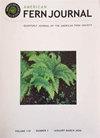巴西亚马逊Serra dos Carajás特有种的形态可塑性
IF 0.9
4区 生物学
Q4 PLANT SCIENCES
引用次数: 1
摘要
摘要Isoëtes cangae和Isoës serracarajensis(Isoetaceae)是Carajás(巴西帕拉州)的特有物种,在季节性降雨条件下生长在亚马逊盆地富含铁的基底上。除了一些独特的形态特征外,该物种在栖息地和地理分布方面也有所不同。季节性和栖息地特征对鹅毛草形态的影响尚不清楚。为了评估这种影响,在旱季和雨季对一个cangae种群和四个serracarajensis种群的标本进行了采样,以研究营养和生殖特征之间的变化。大孢子囊的颜色、大孢子的纹饰、囊长、绒毛长度和覆盖率(%)、孢子囊壁细胞的形态计量学以及大孢子的极/赤道直径比为物种划分提供了一致的特征。细尾蠊存在气孔是一项新发现,与两栖习性有关。Isoëtes物种描述中使用的一些特征,如叶片数量、叶片长度、孢子囊大小、大孢子数量和大孢子直径,被发现是可变的。目前的发现为该物种的生物学提供了进一步的信息,并显示了季节性和栖息地特征对这些番茄属植物形态多样性的影响。本文章由计算机程序翻译,如有差异,请以英文原文为准。
Morphological Plasticity in the Endemic Isoëtes Species from Serra dos Carajás, Amazonia, Brazil
Abstract. Isoëtes cangae and Isoëtes serracarajensis (Isoetaceae) are species endemic to Carajás (Pará State, Brazil) that grow on iron-rich substrates of the Amazon basin under a seasonal rainfall regime. In addition to a few distinctive morphological traits, the species differ in terms of habitat and geographical distribution. The influence of the seasonality and habitat characteristics on quillwort morphology is poorly understood. To assess this influence, specimens from one population of I. cangae, and four populations of I. serracarajensis, were sampled in dry and rainy seasons to investigate variation among vegetative and reproductive characters. The megasporangium color, megaspore ornamentation, alae length, velum length and coverage (%), morphometry of sporangial wall cells, and polar/equatorial diameter ratio of megaspores provide consistent characters for species delimitation. The presence of stomata in I. serracarajensis is a new discovery and is related to its amphibious habit. Some characters that have been used in Isoëtes species descriptions, such as the number of leaves, leaf length, sporangium size, number of megaspores, and megaspore diameter were found to be variable. The current findings provide further information on the biology of the species and show the influence of seasonality and habitat characteristics on the morphological diversity of these lycophytes.
求助全文
通过发布文献求助,成功后即可免费获取论文全文。
去求助
来源期刊

American Fern Journal
生物-植物科学
CiteScore
1.20
自引率
0.00%
发文量
28
审稿时长
6 months
期刊介绍:
The American Fern Journal is a peer-reviewed journal focused on the biology of ferns and lycophytes.
 求助内容:
求助内容: 应助结果提醒方式:
应助结果提醒方式:


